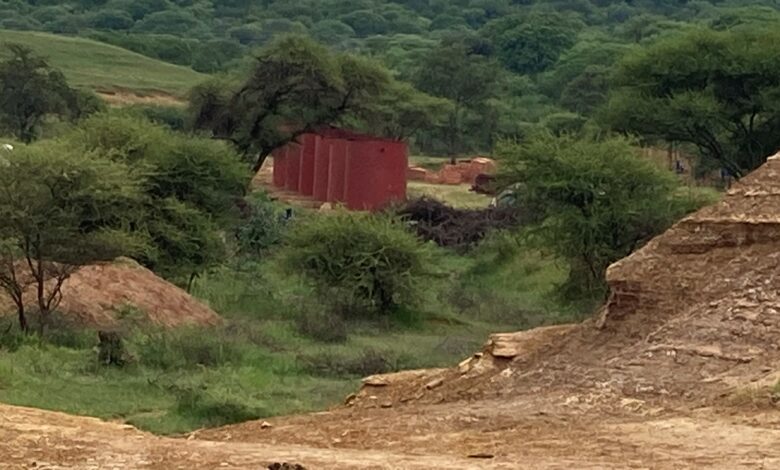Environmental catastrophe looming in Maphisa
…As gold miner sets up plant near Antelope Dam

An environmental catastrophe is looming in Maphisa growth point, in the gold-rich Matabeleland South province following the controversial setting up of a Carbon In Pulp (CIP) plant a few metres from Antelope Dam by a gold miner – Inyamazane Gold Private Limited –investigations by CITE have since revealed.
Maphisa residents accuse the company of using ‘political connections’ to go ahead with the project which was condemned by the community for the threat it poses to human life, livestock, and the environment.
Carbon in pulp (CIP) refers to an extraction technique for the recovery of gold which has been liberated into a cyanide solution as part of the gold cyanidation procedure.
Registered in 2018 Inyamazane Gold was given a contract/ tribute which will run for almost 10 years by Falcon Gold.
Despite initial objections by key stakeholders such as the Matobo Rural District Council (MRDC), community, and the Environmental Management Agency (EMA), the company went ahead and began erecting tanks after ‘successfully appealing’ to the EMA director-general in Harare.
This has, however, not gone down well with the generality of the Maphisa community which still feels unsafe with a CIP plant close to the dam and has questioned the decision by Harare in disregarding concerns of locals whose lives are at risk.
“From what I know, the environmental impact assessment process should involve a lot of stakeholders – government stakeholders, that is EMA, local authority (MRDC), the District Development Coordinator (DDC)’s office, Ministry of Health through Environmental Health and the community,” said a concerned Maphisa resident, who requested not to be named in fear of victimisation.
“But there were shortcuts along the way. The local authority and EMA made an effort to actually stop them but after about six months they came back with papers from Harare claiming they had been authorised.”
The resident said the Maphisa community was very much concerned about the location of the plant using toxic chemicals close to the water body.
In 2013 residents of Gwanda went for at least two weeks without water after cyanide, which can kill instantly if swallowed, was found in the town’s river system. Moreover in 2015 more than 60 elephants died of cyanide poisoning at Hwange National Park in a space of a month.
With a holding capacity of 15 million cubic meters, Antelope Dam which was built in 1971 covers a surface area of 310 hectares and is 18.3 metres deep.
The dam is the source of domestic water for the Maphisa growth point, ARDA Antelope Irrigation Scheme, and livestock.

What aggravates the Maphisa residents’ concerns is that a similar CIP plant in the same growth point that processes mine dumps sourced from elsewhere has already produced a huge heap of toxic waste along the Maphisa-Gwanda Road in just less than a year of establishment. Should cattle access the place, disaster is inevitable.
“We have got another one that is actually less than a year old and they already have volumes of soil that you can never imagine,” decried the resident.

Inyamazane Gold Project, the resident said, came as a competitor to the one already underway.
“We would actually have no problems with the project being relocated elsewhere so that they (Inyamazane Gold) actually process the dump elsewhere not near a water body that supplies the community with domestic water, water for livestock, and then water for irrigation,” he said.
This is not the first time authorities have controversially allowed mining to take place in an unsuitable place with the government having succumbed to pressure in September 2020 and banned all mining activities at Hwange National Park, which it had earlier approved.
Further investigations by CITE have revealed that residents who have since written to Matobo North legislator Edgar Moyo seeking for his intervention and also want the Parliamentary Portfolio Committee on Mines and Mining Development to probe the issue.
“If they (Inyamazane Gold) are not stopped these guys might actually erect their tanks and start operations anytime,” said the resident.
“One thing that we have to consider is that plants such as this one affect underground water. It will be difficult in future to drill boreholes because of water contamination.”
Moyo who confirmed receiving a complaint about the CIP plant being set up in his constituency is of the view that people’s lives should not be endangered.
“I got to know about that plant last week when someone sent me a very long analysis of what was happening,” he told CITE.
“That person indicated that EMA Maphisa had not given a nod to that plant, so there was no more need to talk to EMA Maphisa about it so I went ahead and spoke to the Minister responsible for EMA who is Nqobizitha Mangaliso Ndlovu. I sent him that dossier which had been sent to me and spoke to him about it that we need to urgently put a stop to that because we cannot endanger people’s lives for the sake of making money by some people.”
The Matobo North legislator indicated that when he later met Ndlovu in Harare last Thursday the latter indicated that he had already gotten in touch with the director-general of EMA regarding that matter.
“It is my hope and trust that at the highest level of EMA that matter is being attended to,” he elaborated.
Obey Chaputsira, Matobo DDC, said his office was consulted on the project and made some recommendations for the company to follow.
“It’s true the place where the plant is being sited is close to a dam,” said Chaputsira.
“I understand initially the environmental impact assessment was rejected at the provincial level. However, in terms of the law, they were allowed to appeal to higher offices and the environmental impact assessment was out; they also shared with me a copy of the same. So, I think everything was legally approved though there are reservations within the community because of its (the plant) closeness to the water body because that’s the water body that serves Maphisa’s growth point.”
Chaputsira said while the project had been legally approved, concerns of the community should not be ignored.
“Since it is something that has been accepted legally, we are trying to find a way how best we can try to sit down with the company and also maybe consult EMA on what we really have to do to highlight the concerns of the community,” he said.
However, Joseph Mpasi, Inyamazane Gold Private Limited, public relations, and contracts director says everything is above board and EMA issued the EIA certificate when they appealed against the decision to bar them.

He said the certification came with special conditions, which they have to meet to ensure the safety of both residents and the environment. The conditions include among others, the company plastering the boundary wall surrounding the plant to prevent leakages, compacting the proposed cut-off trench to minimise soil erosion, and putting in place adequate measures to ensure all spillages are contained on-site and guaranteeing zero discharge of effluent into the environment.


Mpasi said the MRDC, DDC’s office, and local traditional leader, Chief Fuyane consented to the project.
“There is no way anywhere where you can put a plant and the plant has got no mitigation measures, ” said Mpasi.
“Even if you are to put 5km away from the dam you still need to have mitigation measures then you would convince the authorities to give you the EIA which then happened. We gave them the mitigation measures. Through necessary procedures, we have managed to secure the EIA certificate. If you look at the dam versus the plant you would understand that according to the Act it says about 500m from the highest flood level, which is what we have done. That’s where we are.”
But Maphisa residents say the distance between the dam banks and the plant is about 100 metres while EMA could not be drawn into giving specifics on that.
He said they were concerned that people were attacking them on social media without seeking any clarifications from them.
“The chief consented and said there is no problem as long as we do not work on a shaft that is suspected to have human remains, which we do not have the intention to work on,” he said.
Bodies of people murdered during the Gukurahundi massacres are believed to have been thrown into one of the shafts in the area.
“Surprising before we even started, people are starting to say we are doing the wrong thing,” said Mpasi.
“I think people should be patient with us and give the authorities time to come and do the checks. Anyone is entitled to say what they think but the truth of the matter is that we are here for business we are not there to kill people. As far as we are concerned we are on the right track.”
He said they were looking at producing not less than 20kg of gold per month once the process begins.
Asked why not move the plant away from the dam and still process the same mine dump, Mpasi said that does not make any economic sense as they want to utilise part of the infrastructure at the old plant established long before the dam was built.
Mpasi denied that he used his political connections for his company to be later cleared to carry out operations in Maphisa.
“What political connections?” he queried.
“Look, I am not connected to anyone. I am not anywhere connected to anyone. What I know is I am free to go to any office as per the policy of the President that he always says my door is always open to everyone. Why would I use anyone? And I don’t have any reason to use anyone.”
The businessman said it was within his rights provided for in the law to appeal against EMA’s initial response to the application.
Chief Fuyane confirmed meeting Inyamazane Gold representatives but was quick to say the granting of the permission for the company to do its operations lies with relevant government departments such as EMA.
“Yes, Inyamazane came and we spoke to them but as you know, we speak as traditional leaders without deep knowledge about the plant they want to set up and how it is going to operate as we are told it is close to a water body,” he told CITE.
“I told them that meeting with me does not mean I am giving them a go-ahead to set up the plant or denying them permission to do the same.”
EMA district officer stationed at Maphisa, Urorisoe Makhurane, and Matabeleland South manager, Decent Ndlovu in Gwanda, declined to comment on the issue and instead referred all questions to the agency’s Environment Education and Publicity Manager, Amkela Sidange, in Harare.
“First and foremost l want to make it known that an EIA process is quite involving and rigorous such that the decision to issue a certificate is not the sole decision of the Agency but is informed by recommendations from various and relevant stakeholders and departments that EMA triangulates with its own expert judgement as the environmental watchdog,” said Sidange.
“In the case of the project in question (Antelope Gold Mine), when the project proponent submitted the EIA report to the EMA, the Agency outrightly rejected the proposed project on site suitability sighting that the proposed project was not compatible with the current land use and also considering the ecological sensitivity of the area. However, the proponent appealed against the decision by the agency as provided by the law if the proponent is not satisfied with the decision taken.”
Sidange said the appeal resulted in further interrogation of the proposal by expert departments which then recommended for the EIA certification with conditions among which was zero discharge of effluent to the environment and erection of silt abatement measures.
“The conditions also evoked powers for the Director-General of EMA to either cancel, amend or suspend the certificate in the case the conditions are violated,” said Sidange.
“Thus the EIA certificate was issued with conditions based on recommendations from the expert departments to avert any environmental pollution and degradation.
Otherwise, the agency wants to applaud the residents for exhibiting environmental stewardship of that highest level by fighting for their birthright as enshrined in section 73 of the constitution and as the Agency we remain committed to ensuring this birthright is not violated through promoting sustainable environmental management practices.”






